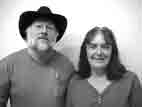 |
Gary & Louise Lee
Gary & Louise Lee have been in business together for over 30 years. They operate Advantage Customs at 6400 N Broadway, one of the leading auto and truck accessories businesses in the Midwest. They are most knowledgeable in all areas including Truck Tops and lids, pickup bed covers, tonneau covers and just about every accessory item manufactured for your car or truck. They custom build "flatbeds" for pickups for farm and ranch uses. Gary and Louise are also heavily involved in "tractor pulls" all around the area, and have won a number of events. You can reach them at (316) 744-0454 , or email them at garanwisey@aol.co |
Cars, Trucks, Vans & Automotive
2003-06-01 10:13:00
History of the Jeep
: I thoroughly enjoyed your multi-part series on Toyota and its history. Much of the content continually referred to Jeep. Can you provide the same on it and its history?
ANSWER: I will give it a try. Here's what I can find: John North Willys bought the Overland Automotive Division of Standard Wheel Company in 1908 and in 1912 named it the Willys-Overland Motor Company. Willys-Overland made both automobiles and trucks. The company was reorganized in 1936 after a depression bankruptcy to Willys-Overland Motors, Inc. Some of the coolest street rods are built from pre-WW2 Willys cars. The Birth of the Jeep As the war in Europe spread in the late '30s, the U.S. Military wanted a new lightweight, four-wheel-drive, reconnaissance vehicle. They solicited bids for command/reconnaissance car with an 80" wheelbase and weighing 1300 lbs. in June of 1940. Three companies responded: Bantam, Ford and Willys. The Bantam Car Company had the leading contender based on overall design, but Willys had the wonderful "Go Devil" flat-head four-cylinder engine. Ford had some good ideas too and there was a pooling of ideas that surely violated the spirit, if not the letter, of intellectual property, trade-mark, and other laws, but served the governments needs. The final winner after a few resubmittals was the GPW. "G" for government, "P" for pigmy (a Ford term) and "W" for Willys. One story has it that the lowly, uninformed GI's thought "GP" was for general purpose, and pronounced it "jeep". Other people say that the word "jeep" was slang for any wonderfully multipurpose thing. The Popeye cartoon had a character, named "Eugene the Jeep" in 1936, who had all kinds of amazing powers. Anyway, the source of the name "Jeep" is now veiled by the passage of time... but on with the story. The government selected a vehicle based mostly on the design by the Bantam Car Company. Bantam didn't have the mass production facilities needed to supply the government, and the military wanted multiple suppliers. Willys got a contract to build "jeeps" in late 1940. Ford was also awarded a contract a week later. Many parts were interchangeable between the Willys and Ford jeeps. Of the roughly half million jeeps produced for WW2, Willys-Overland made about 360,000 between 1941 and 1945. The jeeps proved to be rugged and dependable in the war, and by the time the soldiers came home, jeeps were well known and loved for their durability and unstoppability. Next month, we’ll continue with the history of the jeep following World War II.


